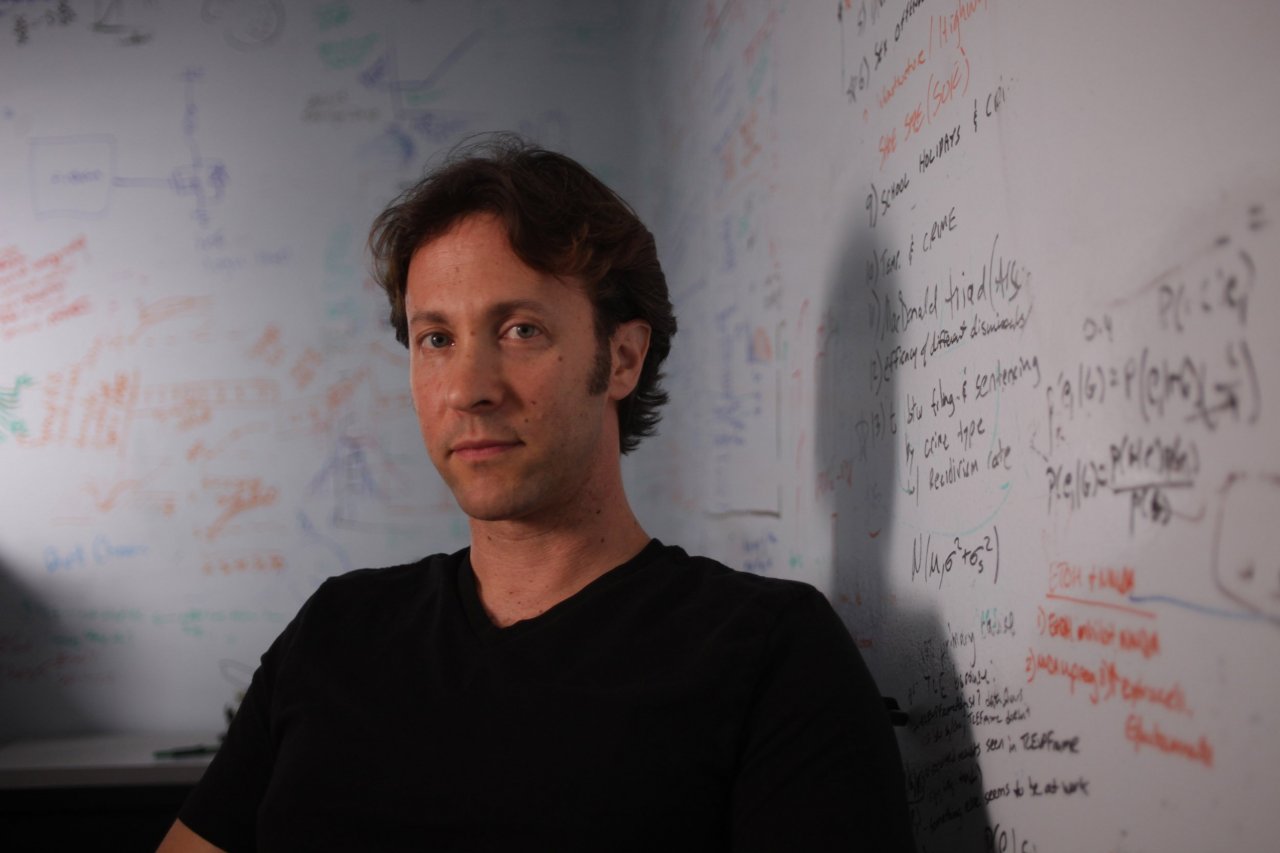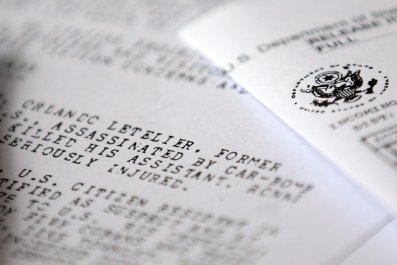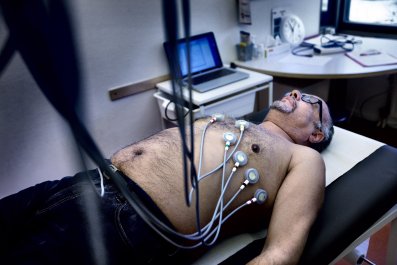The brain is a battlefield, says neuroscientist David Eagleman. You might think you're making single-minded decisions, but you're really not. "Instead, you are made up of multiple drives, all of whom are trying to be in control," he says. Despite being a bit disconcerting—Am I not who I think I am? What are these voices in my head?—the "team of rivals" brain model might, Eagleman believes, pave the way toward the end of drug addiction in the United States, if he can figure out how to teach people to harness those myriad drives.
He's currently in the early stages of a project at his lab at the Baylor College of Medicine that uses real-time feedback in brain imaging to, essentially, reshape how addicts react to their particular bête noir. "You've got these different neural networks that all have purposes and agendas," he says. "Part of your brain really wants something, then there are other networks trying to resist it. We're trying to help people to see these battles under the hood and tip the scales." Eagleman connects his subjects to an MRI machine, then shows them photos of drug paraphernalia; he instructs them to alternately allow their cravings to overwhelm and then suppress their urgings for their drug of choice, charting their neural responses on-screen via a gauge similar to a speedometer. His theory is, with practice, the subject will be able to hone their resistance impulse toward these powerful triggers.
"I call this 'the prefrontal gym'—it's just like going and working out, figuring how to move the needle. The idea is by strengthening your capacity to suppress your craving, when you're out in the real world, you'll still want it, but you'll have the cognitive tool to resist," says Eagleman energetically.
Early footage from these trials creates a particularly dramatic interlude of The Brain With Dr. David Eagleman, his new documentary miniseries for PBS. Written and hosted by the scientist, the program (which premiered on October 14) attempts to educate neuroscience neophytes on the most fundamental processes of our most important organ: how it channels thought, how it processes reality, how it functions in both conscious and unconscious states.
Much like his childhood hero, Carl Sagan (and Sagan's Cosmos heir, Neil DeGrasse Tyson), Eagleman is a gregarious communicator well-honed for TV; he cuts an earnest, convivial figure as he translates dense research into lean layman's terms. The Guggenheim fellow often brims with youthful glee as he breaks down his own career focuses of synesthesia (a condition in which information between the senses is blended), time perception (how one interprets the temporal order of events in the world, from tactile to visual and auditory sensations) and neurolaw (how neuroscience research findings should dictate societal constructs, from criminal punishment to how juries should weight unconscious actions). He often employs some form of flashy visual metaphor, whether he's clad in full baseball regalia to hit a fastball (to demonstrate unconscious physical reaction) or go spelunking in a foreboding cave (to replicate the dark confines of the human cranial cavity).
The scientist's own résumé is pretty surreal, including a volunteer stint in the Israeli army, an undergraduate degree in British and American literature from Rice University, and a short foray as a stand-up comedian in Los Angeles. He's also authored a best-selling fictional work, Sum: Forty Tales From the Afterlives, which whips up ingenious alternatives to the usual binary argument of the religious heaven versus the atheistic void; in one tale, God is the size of a microbe, with no comprehension of humanity. In another, the undead relive their most common earthly activities in time-blocked spans: They spend six unyielding days clipping their nails, two years feeling bored, 200 days showering, etc. Eagleman's most celebrated nonfiction book, Incognito: The Secret Lives of the Brain, delves into chewy pontifications of free will, neural contradictions and biological interdependence, while also allotting space for the odd Mel Gibson burn.
Eagleman's theatrical flair also extends to his research projects. In a talk he gave at a TED (Technology, Entertainment, Design) conference this spring, to debut a vest of his invention that translates audio information into tactile sensations, he ripped off his navy button-down shirt mid-stride, unveiling the glowing white garment as proudly as Superman unfurling his cape. In 2007, to test whether time actually slows down for someone during a life-threatening experience—or whether the amygdala's thorough capturing of details merely feels longer in that panic or whether "you're seeing time stretched out, like Neo in The Matrix, or it's just a retrospective trick," as Eagleman translates—he and a grad student, Chess Stetson, dropped participants in 110-foot freefall from the tower of a local amusement park ride into a net. Amid their shrieking, the subjects tried to read numbers flashing on specialized wristwatches at a rate slightly faster than what humans can normally perceive; if they were actually seeing the world at a slower pace, they'd be able to detect the numbers. (Their findings: Neo alone had that ability.)
Though Eagleman has taken on a strong ambassadorial role for neuroscience—becoming a sort of "public intellectual," according to his peer Michael S. Gazzaniga of the University of California Santa Barbara—his addiction research may yield a real impact in the field. Eagleman's work in this field re-examines the potential of neuroscanning and the use of MRI machines to treat addiction. Though they are most commonly used to detect neurological cancers and diseases to the central nervous system, such as epilepsy and dementia, MRIs are also well-suited to detect the slight changes of rewired associative patterns. It's not a purpose that has been explored at length yet, or channeled into larger rehabilitative efforts the way Eagleman is attempting, but the potential is there. Hollywood recognized that in 2004: The movie Eternal Sunshine of the Spotless Mind had a similar premise, with rogue scientists strapping "patients" into brain scanners and charting their neural reactions toward ex-lovers.
Eagleman's real-world version is a sort of advancement of cognitive behavioral therapy, a popular type of psychotherapy; this process identifies negative thought patterns and works to curb those triggers gradually. Twelve-step programs hinge on this system; it's a cornerstone of Narcotics Anonymous, and has been endorsed by the National Institute on Drug Abuse and the American Psychological Association as one of the most effective methods currently available for preventing drug relapse. (Though only a small percentage of the estimated 20 million Americans age 12 and older who regularly use illegal drugs seek treatment, both note.)
"I think what we're doing is in alignment with other methods that people do, like meditation and cognitive therapy," says Eagleman, "but we're putting that on turbo boost." Dr. Marvin Seppala, chief medical officer of the Hazelden Betty Ford Foundation, calls Eagleman's approach "remarkable." "I think it could really be helpful, because craving is one of the essential features of addiction and contributes to the long-lasting potential for relapse," says Seppala, who has not worked with Eagleman. "The reward center of the brain is subcortical, so it's kind of subconscious. If you can see how much your brain is being altered by such things, and work in real time to reduce how that alteration occurs, I think that could be really powerful."
However, Seppala had reservations about the method taking off as widely as Eagleman aspires, if only for the prohibitive costs of neural scanning. "I'd have doubts, only because of the continuing financial pressure from insurance companies and other payers to limit the cost of health care," he says. The average cost of MRI brain scanning exceeds $1,100 in the U.S.—and insurance companies have become so reticent to cover MRIs, it's become a subject of research papers. Seppala adds, "Also, craving is only one aspect of addiction. There is also compulsion to continue to use, loss of control, and diminished recognition of the problem itself, which is part of the issue of frontal lobe damage."
Eagleman's addiction approach, with its futuristic bend, also seems to appeal to the same dramatic inclinations of his career. "Hey, science is hard. There's a lot of work, there's so much competition for grant funding and publishing. I feel like there are a million ways people can go down rabbit holes and do things that end up being really boring," he says. "When I thrive is trying to do the experiments that get me out of bed in the morning."






















